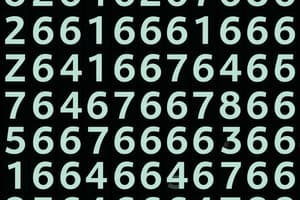Podcast
Questions and Answers
What role do mathematical symbols play in expressing concepts in mathematics?
What role do mathematical symbols play in expressing concepts in mathematics?
Mathematical symbols play a crucial role in expressing complex concepts and ideas.
How are numbers represented in mathematics?
How are numbers represented in mathematics?
Numbers can be represented by digits (0-9) or letters (a-z).
What are some examples of arithmetic symbols?
What are some examples of arithmetic symbols?
Arithmetic symbols include addition (+), subtraction (-), multiplication (*), division (÷), exponentiation (^), and modulus (%).
What do relational symbols represent?
What do relational symbols represent?
Give an example of a relational symbol that denotes a value greater than another value.
Give an example of a relational symbol that denotes a value greater than another value.
Explain the significance of arithmetic symbols in mathematics.
Explain the significance of arithmetic symbols in mathematics.
Flashcards are hidden until you start studying
Study Notes
Mathematical symbols play a crucial role in expressing complex concepts and ideas within the field of mathematics. These symbols help to define operations, relationships, and functions that are fundamental to understanding various mathematical principles. In this article, we will explore some of the most commonly used mathematical symbols and their meanings.
-
Numbers: Numbers are numerical values assigned to quantities, and they can be represented by digits (0-9) or letters (a-z). For example, '5' represents the number five, and 'x' could represent any value depending on the context.
-
Arithmetic Symbols: Arithmetic symbols denote basic arithmetic operations such as addition (+), subtraction (-), multiplication (*), division (÷), exponentiation (^), and modulus (%). These operations are used to manipulate and compare numbers.
-
Relational Symbols: Relational symbols represent the relationships between numbers and are used to compare them. Some common relational symbols include:
- Greater than (>): '>' represents a value greater than another value.
- Less than (<): '<' represents a value less than another value.
- Equal to (=): '=' represents that two values are equal.
- Not equal to (≠): '≠' represents that two values are not equal.
- Greater than or equal to (≥): '≥' represents that a value is greater than or equal to another value.
- Less than or equal to (≤): '≤' represents that a value is less than or equal to another value.
-
Logical Symbols: Logical symbols are used to represent logical operations in mathematics, such as conjunction (∧), disjunction (∨), and implication (→). These symbols are used to combine and connect statements and propositions.
-
Set Theory Symbols: Set theory symbols are used to represent and manipulate sets, which are collections of objects. Some common set theory symbols include:
- Union (∪): The union of two sets represents the combined set of all elements that are in either or both sets.
- Intersection (∩): The intersection of two sets represents the set of all elements that are in both sets.
- Difference (−): The difference of two sets represents the set of all elements that are in the first set but not in the second set.
- Complement (∖): The complement of a set represents the set of all elements that are not in the original set.
-
Algebraic Symbols: Algebraic symbols are used to represent algebraic operations and relationships. Some common algebraic symbols include:
- Variable (x, y, z, ...): Variables represent unknown or changing values.
- Constant (a, b, c, ...): Constants represent fixed, known values.
- Equal to (=): '=' represents that two expressions are equal.
- Not equal to (≠): '≠' represents that two expressions are not equal.
- Less than (<): '<' represents that one expression is less than another.
- Greater than (>): '>' represents that one expression is greater than another.
- Less than or equal to (≤): '≤' represents that one expression is less than or equal to another.
- Greater than or equal to (≥): '≥' represents that one expression is greater than or equal to another.
These mathematical symbols are essential tools for mathematicians and are used to express and manipulate mathematical concepts and ideas. Understanding the meaning and use of these symbols is crucial for learning and working with mathematical concepts.
Studying That Suits You
Use AI to generate personalized quizzes and flashcards to suit your learning preferences.




